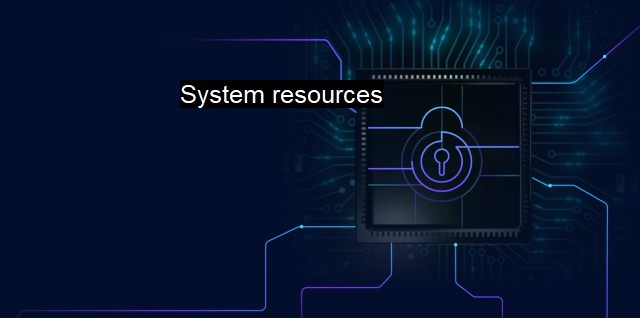What are System resources?
Managing and Securing System Resources for Ultimate Cybersecurity Protection: Understanding the Role of RAM and CPU in Antivirus Context
System resources are valuable components in a computer system that can be used to perform various tasks when instructed by users or software applications. These resources include hardware components such as the central processing unit (CPU), random access memory (RAM), disk space, bandwidth among others, and software components like applications, services, databases, and files. For a computer system to run efficiently, these resources need to be effectively managed and protected. There are cybersecurity threats that can compromise system resources, and this is where the field of cybersecurity and the use of antivirus software come into play.System resources can be key targets for attackers or malicious software. Hackers exploit vulnerabilities in a system to install unauthorized software or to take control of system resources, potentially causing a significant impact on system performance and reliability. Some malware, for instance, has the ability to use system resources to perform malicious activities completely unbeknownst to the system owner. This includes using the system's processing power to mine cryptocurrency, copying sensitive files, or leveraging the machine as a node in a botnet for carrying out Distributed Denial of Service (DDoS) attacks.
Viruses and other types of malware may destroy or corrupt important system files, rendering certain functions of the computer unavailable. This could lead to system crashes, unexpected rebooting, and other issues. Some malicious software can replicate themselves, causing an unnecessary consumption of system resources. Such actions not only slow down the computer and cause inconvenience to users, but they also pose risks to the security of stored information. once a hacker gains control of a system's resources, they may implement various types of attacks, such as data theft, ransom attacks, or spamming activity using the system's network resources.
This makes it necessary to have strong cybersecurity measures in place to protect system resources. Key among these measures are comprehensive and updated antivirus software programs. Antivirus software serves as the first line of defense against the myriad threats that can harm system resources. They are armed with customizable features that enable them to screen every incoming file, scan every piece of data, and protect against malicious software even before it breaches the system.
Modern antivirus software goes beyond merely scanning for known threats. They incorporate a range of cutting-edge technologies, including machine learning and artificial intelligence, to anticipate new and evolving threats. Sophisticated antivirus applications perform real-time scanning of your system, meticulously checking each file opened, application initiated, or URL accessed. They also regularly update their databases to stay in step with the rapidly evolving malware landscape.
Antivirus software helps in managing system resources by providing protection against malicious cryptojacking software that can surreptitiously hog system resources. A robust antivirus program is equipped to identify such invasions and quickly terminate them, reallocating the systems resources to legitimate uses and thus, preserving the system's performance and extending its useful life.
Unprotected system resources are attractive targets for cyber threats looking to exploit their computing power or use them as a launchpad for larger-scale attacks. Therefore, the role of cybersecurity in safeguarding system resources from unauthorized access and misuse cannot be overstated. This is achieved through a consolidated approach that includes the effective use of antivirus software to counter the multifaceted threats that are a perilous part of the digital environment, thus, delivering confident security for system resources and the information they hold.

System resources FAQs
What are system resources in the context of cybersecurity and antivirus?
System resources are the hardware and software components of a device that are used by the operating system and running applications. In the context of cybersecurity and antivirus, system resources are critical to ensure the performance and protection of your device against malware and other cyber threats.Why is it important to monitor system resources for cybersecurity and antivirus purposes?
Monitoring system resources is important for cybersecurity and antivirus because it provides insight into the health and performance of your device. By monitoring system resources, you can detect any abnormal activity that may indicate the presence of malware or other cyber threats. This information can then be used to take action to protect your device and data.What are some examples of system resources that can be affected by malware and cyber threats?
Examples of system resources that can be affected by malware and cyber threats include CPU usage, memory usage, network bandwidth, and storage space. Malware and other cyber threats can consume system resources, slow down your device, and cause it to crash or become unresponsive.How can I optimize my system resources for better cybersecurity and antivirus performance?
To optimize your system resources for better cybersecurity and antivirus performance, you can take several steps such as regularly updating your antivirus software and operating system, minimizing the number of running applications, disabling unnecessary startup programs, and avoiding risky online behavior such as clicking on suspicious links or downloading unknown files. You can also use system monitoring tools to keep track of your system resources and identify any issues that need to be addressed.| | A | | | B | | | C | | | D | | | E | | | F | | | G | | | H | | | I | | | J | | | K | | | L | | | M | |
| | N | | | O | | | P | | | Q | | | R | | | S | | | T | | | U | | | V | | | W | | | X | | | Y | | | Z | |
| | 1 | | | 2 | | | 3 | | | 4 | | | 7 | | | 8 | | |||||||